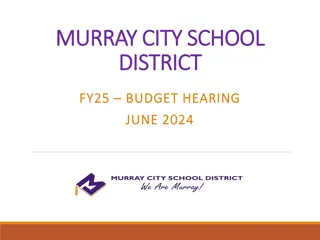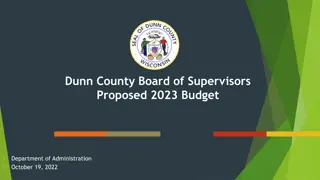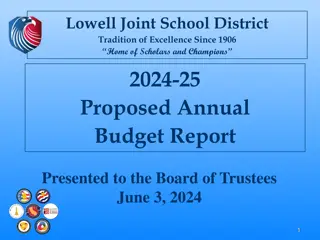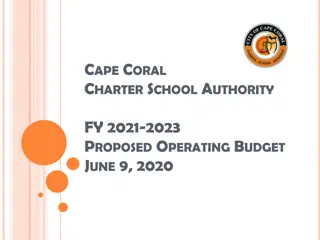Proposed Changes to School Aid in the 2024-25 Executive Budget
The 2024-25 Executive Budget proposes significant changes to School Aid, including adjustments to Foundation Aid calculations. The budget aims to increase total School Aid by $824 million, with reductions in Foundation Aid for some districts. These changes are justified by concerns about sustainability and the need to address disparities in funding allocation. The impact of the proposed reductions on various district categories is outlined, highlighting the potential effects on general fund expenditures and tax levies.
Download Presentation

Please find below an Image/Link to download the presentation.
The content on the website is provided AS IS for your information and personal use only. It may not be sold, licensed, or shared on other websites without obtaining consent from the author.If you encounter any issues during the download, it is possible that the publisher has removed the file from their server.
You are allowed to download the files provided on this website for personal or commercial use, subject to the condition that they are used lawfully. All files are the property of their respective owners.
The content on the website is provided AS IS for your information and personal use only. It may not be sold, licensed, or shared on other websites without obtaining consent from the author.
E N D
Presentation Transcript
THE 2024-25 EXECUTIVE BUDGETAND PUBLIC SCHOOLS January 2024
School AidThe Big Picture Budget proposes an $824 million (2.4%) increase in total School Aid: $507 million (2.1%) increase in Foundation Aid $318 million (3.2%) increase in expense-based and other aids Foundation Aid is reduced by $420 million below what current law formulas would generate (a 3.9% increase). Other aids are funded in accordance with current law 2
Foundation Aid Changes 1) Apply a lower inflation adjustment: Current law calls for the per pupil Foundation Amount to be increased by 4.1% based on average monthly change in the Consumer Price Index over 2023. The budget would substitute an adjustment based on the average annual change in the CPI over the last 10 years, excluding the highest and lowest years lowers adjustment to 2.4%. For districts not on save-harmless, this typically reduces Foundation Aid increases by 1.4 percentage points from State Education Department November estimates (e.g. from 3.9% to 2.5%).* 2) Reduce Save-Harmless: With save-harmless, districts will not experience a reduction in aid over the prior year. Think of the difference between the sum the formula would generate and the prior year aid as the save-harmless amount. The budget would reduce each affected district s save-harmless amount through a wealth-adjusted calculation; maximum reduction would be 50%, the minimum would be 9%. Half the state s school districts would experience year-over-year reductions in Foundation Aid. 54% of those districts would face the maximum 50% reduction in save-harmless funding * In developing its November current law estimates, the State Education Department lacked full-year inflation data and applied a 3.8% inflation adjustment 3
Distribution and Impact of the Save-Harmless Reductions Impact of Proposed Save-Harmless Reduction Districts Grouped by State Education Department Need/Resource Capacity Category Reduction as % of 2023-24 Total General Fund Expenditures Share of Proposed Reduction Reduction in Foundation Aid Reduction as % of 2023-24 Tax Levy High Need Small Cities & Suburbs High Need Rural 3.0% -1.3% -0.5% 1.3% 16.4% -4.0% -1.7% 5.1% Average Need 55.3% -4.8% -1.3% 2.4% Low Need All Save-Harmless Districts Source: NYSCOSS analysis of NYSED School Aid and Property Tax report Card data. 25.3% -8.0% -0.7% 0.9% 100.0% -4.8% -1.1% 1.7% 4
Rationale for the cuts and rebuttal Recent increases were not sustainable Increases moderated on their own with full-funding complete and lower inflation (3.9% under current law) This was not raised as a concern a year ago when Foundation Aid increased 12.3% Schools have been benefiting from large increases True for many, and we are grateful But not all for 40% of districts, Foundation Aid increases did not keep up with inflation over the last 3 years Schools have built up reserves Policymakers should hope so, with federal COVID-relief aid expiring Municipalities have no percentage limit on unrestricted fund balance Districts have lost enrollment causing them to fall on to save-harmless This was not raised as an issue the last 2 years save-harmless was preserved and a 3% minimum increase was provided Schools may be serving fewer students, but they are doing more for students and families than ever before Cutting aid does nothing to improve opportunities for students in districts with significant enrollment declines 5
999999 Enter 6-digit "BEDS" Code here >> For a list of codes, click on CODE LIST tab below On our website www.nyscoss.org Hit "CTRL P" (i.e., control P) to print a report 2024-25 Executive Budget School Aid Proposal The spreadsheet will produce 4 reports for any district: District: TOTAL STATE County: -- Aid Categories Foundation Aid Charter School Transition Aid High Tax Aid Summer Transportation Aid Transportation Aid w/o Summer Building Aid Building Reorganization Aid Operating Reorganization Incentive Aid Non-BOCES Computer Administration Aid Non-BOCES Career Education Aid Non-BOCES Academic Improvement Aid BOCES AID Public Excess Cost High Cost Aid Private Excess Cost Aid Software Aid Library Materials Aid Textbook Aid Hardware and Technology Aid Full-Day Kindergarten Conversion Aid Universal Prekindergarten Aid Supplemental Public Excess Cost Aid Academic Enhancement Aid Total Aid Total Aid excluding Building Aids 2023-24 2024-25 Change % Change 507,079,870 5,003,384 - (60) 148,452,419 (44,526,934) (3,484,064) (657,077) (558,555) 1,270,295 1,521,854 17,928,593 75,056,490 17,435,255 108,698 343,802 (65,873) 456,429 - 99,347,098 - - 824,711,624 872,722,622 23,998,878,704 53,121,966 223,298,324 2,390,011,183 3,382,239,407 14,781,063 31,865,314 139,149,443 50,742,558 1,257,335,643 574,749,672 438,110,697 41,734,600 17,114,268 161,612,606 33,799,069 1,077,588,258 28,271,832 33,926,740,628 30,529,720,158 24,505,958,574 58,125,350 223,298,324 2,538,463,602 3,337,712,473 11,296,999 31,306,759 140,419,738 52,264,412 1,275,264,236 649,806,162 455,545,952 41,843,298 17,458,070 161,546,733 34,255,498 1,176,935,356 28,271,832 34,751,452,252 31,402,442,780 2.1% 9.4% 0.0% 0.0% 6.2% -1.3% -23.6% -21.7% -1.8% 0.9% 3.0% 1.4% 13.1% 4.0% 0.3% 2.0% 0.0% 1.4% All Aids Summary (pictured) 4,999,845 4,999,785 3,023,009 2,365,932 Save-Harmless Summary Foundation Aid Analysis Estimate Changes Over Time - - NA 9.2% 0.0% 0.0% 2.4% 2.9% 4,313,167 4,313,167 CODE LIST tab provides code numbers for all districts SOURCE: Compiled by NYSCOSS from New York State Education Department School Aid data Foundation Aid Summary 2023-24 Foundation Aid Proposed 2024-25 Foundation Aid Proposed Change from 2023-24 Proposed % Change from 2023-24 23,998,878,704 24,505,958,574 507,079,870 2.1% 2024-25 Foundation Aid Under Current Law Proposed Change from Current Law Proposed % Change from Current Law 24,925,689,722 (419,731,148) 6 -1.7%
Foundation Aid Analysis Foundation Aid Funding Analysis District: County: Jonesville CSD Lincoln Presents historical information on some key variables Amount of Save-Harmless Funding (if any) 1,248,359 2023-24 7,072,498 2024-25 6,448,319 Change (624,179) % Change -8.8% Governor's Proposal 2024-25 Governor's Proposal 6,448,319 % Change from Current 2024-25 Current Law 7,072,498 Change from Current Law (624,179) Law -8.8% Current Law Property Wealth/Pupil Ratio** Combined Wealth Ratio** 0.783 K-6 Free and Reduced Price Eligible % English Language Learners Weighted Pupils* 1,366 Income/Pupil Ratio** 2007-08 0.711 0.856 27.1% - 2022-23 2023-24 2024-25 817 808 858 0.871 0.880 0.940 0.816 0.814 0.845 0.843 0.847 0.892 37.0% 34.9% 34.1% - - - All figures in the table directly above are those used in calculating School Aid for that year and are typically derived from a year or more prior to the calculating year (e.g., 2022-23 enrollment for 2023-24 aid) 7
The Save-Harmless Summary Save-Harmless Summary Identifies: District: Jonesville CSD County: Lincoln County Amount of cut, if any 2023-24 Foundation Aid Proposed 2024-25 Foundation Aid 7,072,498 6,448,319 (624,179) -8.8% Cut as % of save-harmless Change % Change Cut as % of total general fund expenditures Save-Harmless Amount, if any* Reduction in Save-Harmless % Reduction in Save-Harmless 1,248,359 (624,179) -50.0% Cut as % of tax levy 2023-24 Total General Fund Expenditures TGFE Reduction Needed to Offset Cut 25,641,075 -2.4% 2023-24 Tax Levy 11,068,886 Tax Levy Increase Needed to Offset Cut 5.6% SOURCE: Compiled by NYSCOSS from New York State Education Department School Aid data 8
Reviewing the Foundation Aid formula 2007 formula was an under-appreciated achievement in public policy, but Study behind basic per pupil amount (Foundation Amount) has not been updated in years Regional Cost Index values have never been updated; current design produces steep differences among neighboring districts Still using 2000 Census poverty data and problems have emerged with Free and Reduced-Price Lunch data Formula includes an Expected Local Contribution there was no property tax cap when the formula began We have learned more about how children s circumstances affect learning 43% of districts are not on the formula under current law for 2024-25 on save-harmless Process for review? Who should lead State Education Department or a commission? SED requested $1 million to support research needed to update Foundation Aid All statewide public school groups supported funding Funding was included in Assembly and Senate one-house budgets But no funding was included in enacted budget ECB groups met with SED several times in August and recommended an approach for the review 9
ECB recommendations: SED cannot do everything without more resources, but it can do some things ECB Update Priorities (Funding not required to conduct update) Update Successful Schools Model and Foundation Amount using outcome-based measures to identify successful districts. Priority Level 1 ECB Study Priorities (Funding may be required for research) Review other methodologies for determining Foundation Amount. Priority Level 3 ECB is not recommending the inclusion of additional costs in the Foundation Amount. Explore factors that might be incorporated into the PNI (e.g., effects of concentrated poverty, homelessness) and the weight given to any current or potential new factors within the PNI (e.g., the 0.5 weighting on behalf of English Language Learners). Priority Level 1 Identify and develop alternative RCI models. Priority Level 2 Formula Element Foundation Amount Pupil Needs Index (PNI) Model available alternative poverty measures to 2000 Census and FRPL e.g., Small Area Income and Poverty Estimates; direct certification data. Priority Level 2 Regional Cost Index (RCI) Update data used to calculate index values (using a three-year rolling average); reconfigure regions to extent possible. Priority Level 2 Eliminate 0.650 floor applied to Income Wealth Index. Determine whether any districts or municipalities may be precluded from raising ELC without a property tax cap override. Priority Level 3 Expected Local Contribution Assess how fiscal dependency and competing municipal needs affect raising the ELC in the state s Big 5 cities. Priority Level 3 Weighted Pupil Count None Review and revise weightings within various pupil counts, including the 1.41 weighting on behalf of students with disabilities. Priority Level 3 A key point: Any one change may have significant positive or detrimental effects for a class of districts. It is necessary to consider packages of changes; that might necessitate deferring any structural changes until more options can be developed. 10
Other Funding Items School Meals: $11 million increase to continue state subsidy for schools participating in Community Eligibility Provision, but would not fund universal free meals. Zero-Emission School Buses: Budget would exclude funds from Environmental Bond Act in calculating Transportation Aid for districts participating in a NYSERDA program, increasing state support. Health and Mental Health Initiatives: Budget increases funding for school-based health clinics and for loan repayment for child mental health practitioners. Funding has not been identified for Governor s Pledge to support a school-based mental health clinic for any school desiring one. There are other mental health-related initiatives. Residential Placement Cost Shift: Budget would continue elimination of state share of room and board costs for residential special education placements; estimated impact of $28.6 million on districts outside of New York City. Career and Technical Education: Budget would provide no increase in BOCES or Special Services Aid to support career and technical education. Smart Schools Bond Act: Budget would eliminate Smart Schools Review Board, allowing SED to make final decisions. State Education Department Staffing: Budget would fund 24 additional SED positions 11
Executive Budget Policy Proposals Science of Reading State Education Department would develop best practices and schools must align curriculum with best practices by 9/1/25 No specific funding except $10 million to train 20K teachers using NYSUT teacher centers Curriculum mandate FAFSA Completion Require all schools to ensure seniors complete FAFSA beginning in the 2024-25 SY Students that are 18 or guardians may waive this requirement. 35K waiver NOT included 12
Executive Budget Policy Proposals Science of Reading State Education Department would develop best practices and schools must align curriculum with best practices by 9/1/25 No specific funding except $10 million to train 20K teachers using NYSUT teacher centers Curriculum mandate FAFSA Completion Require all schools to ensure seniors complete FAFSA beginning in the 2024-25 SY Students that are 18 or guardians may waive this requirement. 35K waiver NOT included 13
The Councils Top 10 Legislative Priorities for 2024 Fix APPR Fix Civil Service Increase Capital Outlay Authority Extend Suspension of Retiree Earnings Limitations Enhance Student Safety Overhaul Zero-Emission Bus Mandate Expand Reserve Fund Flexibility Authorize Late August Instructional Days Support Career and Technical Education Modify the Tax Cap 14
Annual Professional Performance Reviews (APPR) There were extensive discussions among public school groups on how to change APPR, going from December 2022 to the end of the legislative session. Later discussions included the State Education Department. Came close to an agreement. Basic components: Restore local control through negotiated plans with limited state-required elements e.g., specify number of observations, use criteria aligned with state teaching/leadership standards; No requirement to include student performance measures; could use all rubric components; Mandated linkages to high stakes decisions would be repealed. Some points of discussion: Should SED approve plans? What data, if any, should districts be required to report to SED? 15
APPR, continued Major point of contention among groups and SED transition to new system: NYSCOSS and some other groups felt districts should have a permanent option; SED and Big 5 favored requiring eventual transition to new system. Possible compromises both would require transition within 8 years: Position 1: Districts could submit current plan for determination by SED whether it would satisfy new law; district and union would have to agree to submit that plan. Position 2:Districts could continue to use plan develop unless SED determines that plan will not satisfy new law district and union would not have to agree to ask for SED for a determination. Under position 1 both sides would have to agree to submit current plan one side or the other could refuse and thereby force negotiation over a new APPR plan. 16
Zero Emission Buses Current law must be significantly adjusted Only requires ZEB s for routes that are feasible. Remove 100% by 2035 requirement Independent verification of range Additional funding State funded feasibility studies Amortization period of 7-years instead of 12 17
Civil Service Reform System is not just antiquated, it is broken Too few names on lists, too few testing opportunities, tests that don t assess proper skill set, etc. Provisional employees that have provided competent service for 9 months should convert to probationary or permanent employees after 9 months if no test has been offered. List of top 5 Committee to evaluate reforms and recommend them to the Legislature Union opposition is significant 18
Student Safety School safety top priority for school leaders, educators, and parents State should provide specific allocation for school safety with broad allowable uses Promote collaboration between school and law enforcement through the implementation of handle with care programs. Allow long term waivers for retirees working as SRO s Exempt certain expenditures from the tax cap. 19
CTE Aidable Salary Limit We and other statewide organization have advocated increasing the aidable salary limit to $60K over a number of years. This provision is never included in the Executive budget but the one-houses budgets have supported it. Big lift again this year given proposed school aid cuts. 20
Capital Outlay Increase capital outlay from $100,000 to between $250,000 and approximately $450,000 depending on regional construction index. Downstate counties would get higher annual limit to draw legislative support and reflecting cost of living realities. We also support allowing the outlay to be combined into one project by using up to 5 years worth of dollars in one project and allowing the outlay to be spread across multiple buildings. Similar story as the situation with the CTE aidable salary cap. Legislative support, but no final agreement due to cost issues and priorities. 21
Reserve Fund Flexibility Increase unrestricted fund balance from 4% to something more. Some legislative support for an increase but significant political headwinds. 22
Suspension of Retiree Earning Limitations Executive budget did not extend this provision which has been in effect almost continually since March 2020. 810 TRS retirees earned over 35K during the 2023 calendar year. Awaiting ERS data (SRO s and bus drivers) NYSCOSS supports an extension through the 24-25 SY to provide employees with certainty, but would be pleased with a one year extension. 23
Tax Cap Reform Prohibit negative tax caps. Include PILOTs in the tax base growth factor so that district may receive revenue to fund demands for services that tax base additions create. The 2023 State of the State book and Executive Budget briefing book alluded to potential adjustments for PILOTs for housing developments but no action was taken and the Governor veto a bill to cover all PILOTs. 24
August Instructional Days Legislature may mandate more holidays beyond Asian Lunar New Year and Juneteenth Combining a later rating day with August instructional days may save February break 25























